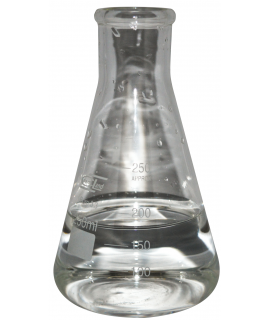PRESERVATIVE C20, (CMIT/MIT), L
2.99 €
01320107
CMIT/MIT, CAS 55965-84-9, isothiazolinones CMIT/MIT, INCI METHYLCHLOROISOTHIAZOLINONE and METHYLISOTHIAZOLINONE
Parameter | Attribute | ||
Preservative C20 | CMIT/MIT, isotiazolinone CMIT/MIT | ||
Formula | C4H5NOS.C4H4ClNOS | ||
Structure |   | ||
IUPAC | 5-chloro-2-methyl-1,2-thiazol-3(2H)-one ir 2-methyl-1,2-thiazol-3(2H)-one | ||
INCI | METHYLCHLOROISOTHIAZOLINONE METHYLISOTHIAZOLINONE | ||
CAS | 55965-84-9 | ||
Molar mass | Mix | ||
Density | 1,22 g/cm3 (20 °C) | ||
Solubility | In water: Maišosi bet kokiu santykiu | In glycerin: Maišosi bet kokiu santykiu | In ethanol: Maišosi bet kokiu santykiu |
Preservative C20 is a traditional preservative used in cosmetic products to protect them from bacterial contamination in CMIT/MIT-based water. Due to its different modes of action, Preservative C20 is a broad spectrum preservative and one of the most widely used and safest preservatives for rinse-off cosmetic products. It is used in both rinse-off cosmetic products and detergents. It is completely soluble in water and polar solvents. Avoid strong redox conditions and amines. It is recommended to be added early in the production process to ensure proper distribution in the system. However, it can be added at any stage of production.
Product benefits:
- Effective against bacteria, moulds and fungi.
- Very low dosage.
- Low cost and very effective.
- Stable up to pH 8 and 50ºC.
- Paraben and formaldehyde free
- Stable in anionic, cationic and non-ionic systems
It is approved for use worldwide. It does not impart color or odor to cosmetic products, is not bio accumulative and biodegrades rapidly.
In wastewater treatment CMIT/MIT preservatives are used to control unwanted micro-organisms. The solution is dosed in water treatment plants at 80 to 100 ppm per cubic meter of wastewater, once or twice a week, depending on the proliferation patterns of micro-organisms such as bacteria and algae.
In the cleaning industry, CMIT/MIT preservative is used in all-purpose cleaners, floor and furniture polishes and waxes, car washes, polishes and waxes, air fresheners, wet sponges and wipes. Its broad spectrum of activity, low toxicity at recommended use levels and excellent chemical compatibility make it a cost-effective and environmentally acceptable alternative to other commercial preservatives.
In cosmetics, preservative C20 is used to protect cosmetics from bioactivity, which over time can lead to souring of products, deformation of jars, delamination of products or other changes in properties. This type of preservative is recommended for use in products that will be rinsed, such as shampoo, conditioner, hair dye, body wash, lotion, sunscreen, mascara, shaving cream, baby lotion, baby shampoo, hair spray, make-up remover, liquid soaps and detergents, or similar. Recommended Ph < 8 Maximum temperature 50ºC Typical dosage 0.05-0.10%. The proposed dose is 0.1%, i.e. 15 ppm. hence the labelling EUH208 but not as H317.
The use of a preservative in leather processing is necessary, especially in tanning/soaking baths, because in addition to the main process, a secondary process is also involved which causes an unpleasant odor and prevents the dye from being absorbed into the leather, discoloration or even simply not setting.
In electrical engineering, the CMIT/MIT-based preservative is used in semiconductor manufacturing, in processes where water-based liquids are used: etching of circuit boards, surface coating of other components, neutralization etc.
In photography, C20 is used in combination with photographic developing reagents as a strong antioxidant and preservative. Thiazolines react very well with free oxygen by binding it, so that other photographic developing components remain effective for longer and the quality of the photographs is not affected.
In the paper industry, CMIT/MIT-based preservatives are used both in the raw material processing and in downstream processes to ensure that paper products are free from biofouling. This type of preservative is advantageous in terms of the quantity used and its lower impact on other paper components.
In metalworking, preservative C20 is used as an auxiliary in machining/cutting fluids. All water-based metalworking fluids can be contaminated with bacteria, algae or mould, resulting in unpleasant odors and changes in fluid properties (viscosity, homogeneity, performance). Both for prevention and in case of contamination, the preservative C20 can be used to prevent further biological processes and to preserve the useful properties of the working fluids for as long as possible.
Important: Add the item to your basket, fill in the recipient's details and confirm your order. Thank you!
To save your precious time, we will deliver your order to your address at a time convenient for You!
*- Pictures of the goods may not reflect the actual appearance, color, assembly or shape of the goods and their packaging. The information in the product description is general and may not correspond to the information on the packaging of the product and may not be accurate as to the use of the product. The information given on the stocks and prices of goods may, in certain cases, differ from the actual prices and stocks of goods
Signal word: Danger |
Hazard icons:
|
Danger phrases: H314 Causes severe eye irritation H317 May cause allergic skin reaction H410 Highly toxic to aquatic organisms, causes long-term effects |
Precautionary statements: P260 Do not inhale fumes/fumes/aerosol/smoke/vapors. P264c Wash hands and body parts that have come into contact with the product thoroughly after use P280 Wear protective gloves/protective clothing/eye/face protection. P310 Call the ACCIDENT CONTROL AND INFORMATION OFFICE/consult a doctor immediately. P303+P361+P353 IN CASE OF CONTACT WITH SKIN Immediately remove/remove all clothing, wash skin with water P305+P351+P338 IN EYES: wash gently with water for several minutes. Remove contact lenses, if present and if easy to do so. Continue washing the eyes. |
01320107
Related products
(8 other products in the same category)













